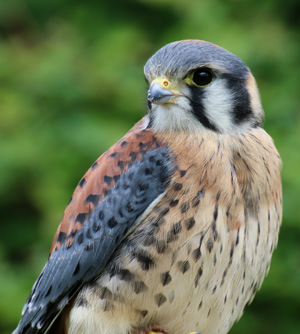by Liz Magnanti

American kestrel. Photo courtesy Flickr: Chris Parker
Stealthy and deadly, birds of prey can be an unwelcome sight to other birds, small mammals, and even homeowners who fear the songbirds at their feeders may soon be dinner. In fact, the word raptor comes from an old word meaning “to seize and carry away.” Birds of prey, however, are a good sign. They are not only interesting to watch, but they are a sign that your landscape is diverse enough to sustain multiple levels of the food web. Often, birds of prey are at the top of their food webs, with other birds of prey being their only potential predators.
The American kestrel is the smallest and most colorful falcon we have in the area. With a maximum length of eleven inches, they can often be misidentified as a songbird or dove. Male kestrels have beautiful blue-grayish head and chestnut orange back. They are easily identified by the two sets of vertical lines they have running down their face. Kestrels can often be seen perched on telephone wires overlooking open fields where they have a great view of their prey, which includes insects, small rodents and birds, and reptiles. Birds can easily find small mammals in large fields due to their ability to see in UV light. The urine from voles, a common prey animal, glows yellow in UV light, making them easier to find.
Sharp-shinned hawks are notorious for hunting songbirds at feeders. Usually a woodland bird, they often come to back yards and are easily spotted in the winter when there are no leaves on the trees for cover. Sharp-shinned hawks are the smallest hawk in the U.S., being about the same size as a blue jay or mourning dove. They can be identified by their bluish-gray back, rusty barring on their breast, and a long, squared-off, striped tail. Sharp-shinned hawks are acrobatic flyers, making it simple for them to catch birds in mid-air.
Cooper’s hawks look like the sharp-shinned hawks’ older brother. They have very similar color patterns and are only slightly larger. Cooper’s hawks have a rounded tail, which is the factor most often used to differentiate them from the sharp-shinned hawk. Cooper’s hawks are also very common in backyards, where they will hunt songbirds. Cooper’s hawks are skillful flyers and can reach high speeds flying through woodlands in pursuit of prey. They were once known as the “chicken hawk” due to their repeated raids on poultry.
The red-tailed hawk is the most common hawk in the area. They are often seen along highways on posts and light poles, perched in search of prey. Red-tails are a large hawk, measuring up to 25 inches in length. They have a distinctive chestnut-reddish tail that is especially visible while in flight. Red-tailed hawks can be found in many habitats and eat a wide variety of foods. Fields, forests, backyards, and cities are all areas they are commonly found. They are known to eat reptiles, small to medium sized mammals, birds, fish, bats, and more! Red-tails have a very distinct call—a long, high-pitched scream that is often used on TV and in movies as the sound effect for any bird of prey.
Arguably our most recognizable bird of prey, the bald eagle is one of the largest birds you will find here. Bald eagles can be found by water, where they actively hunt for fish. They are also known to hunt for mammals and other birds, mainly waterfowl. Bald eagles have a distinct white head and tail, but they do not get this coloration until they are four to six years old. Bald eagles have a spectacular mating ritual, where the male and female will lock talons with each other mid-air, and spiral downwards toward the ground, breaking away before hitting the ground. They are known for their huge nests, which they enlarge each year. Sometimes the nest of a bald eagle can reach up to 1,000 pounds!
During the DDT pesticide years (1940s-1972), many birds of prey were in huge declines and in risk of extinction due to eggshell thinning. Once the pesticide was banned, populations of raptors began to increase. One of the success stories belongs to the bald eagle, which is becoming common to see once again along many waterways. Still, some raptors such as the American kestrel and sharp-shinned hawks are still in decline. Some of this due to direct environmental factors such as loss of habitat, but other reasons remain a mystery. One thing is for sure—birds of prey are magnificent hunters that make a great addition to any landscape.
Liz Magnanti is manager of The Bird House in Brighton.
Views: 4




